Intel X58 Motherboard Roundup - What does $300 Get You?
by Gary Key on December 5, 2008 3:00 PM EST- Posted in
- Motherboards
SATA Performance
PCMark Vantage is the latest benchmark available from Futuremark, and it is only for use with Windows Vista. Similar to the venerable PCMark05 in its makeup, Vantage modernizes the criteria and test methodology to reflect what users may encounter when running the new Windows OS and current applications. The total HDD benchmark is roughly 87% reads and 13% writes in nature. We run each test five times per drive, producing a median score that we use for comparison in our charts. We utilize AHCI settings for each board.
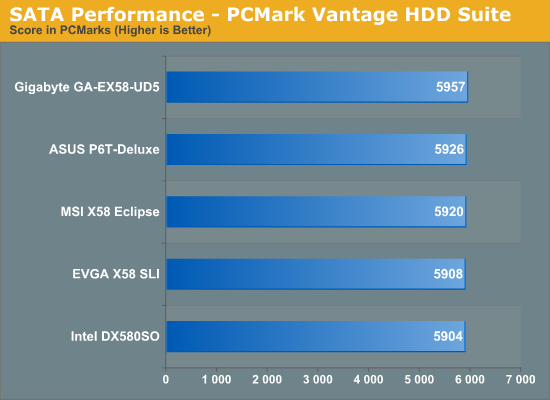

All of the boards utilize the ICH10R for primary storage duties, so there is little difference between the results. In our secondary controller results, we see the SAS solution from Marvell leading the JMicron controllers utilized on the other boards. The MSI and Gigabyte boards both utilize the JMB322 chipset, but we see the MSI board performing better since the JMB322 resides directly on the PCIe bus instead of utilizing the JMB363 as a pass through chip in the same manner that Gigabyte does. EVGA uses the JMB363 chipset and it just barely slides past the Gigabyte setup.
USB / FireWire Performance
Our USB transfer speed tests are conducted with an OCZ Rally 2 Turbo 4GB Flash Drive and USB 2.0/FireWire based Maxtor OneTouch II external hard drive. In the small file test, we transfer a 602MB file folder containing 444 files of various sizes from our hard drive to the USB Flash drive. In the large file test, we transfer a 1.90GB file folder containing 17 different files from our hard drive to the external drive utilizing the USB 2.0 and IEEE 1394a interface.
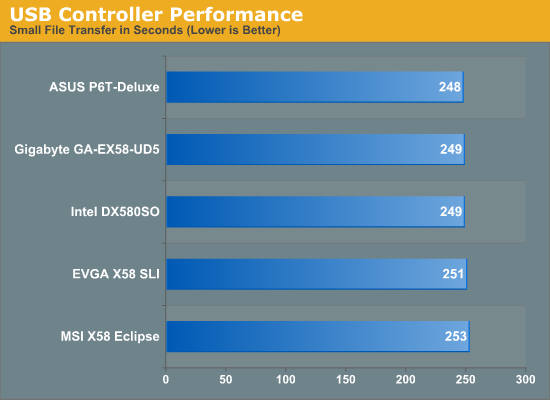
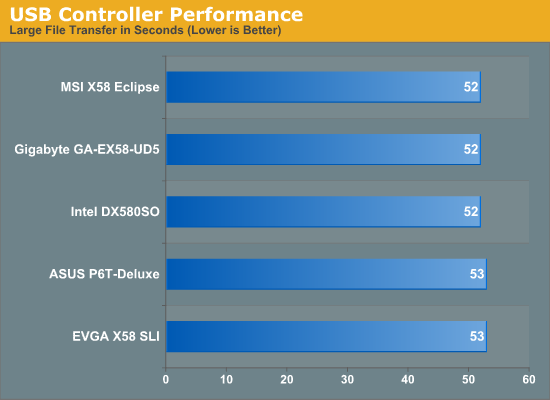
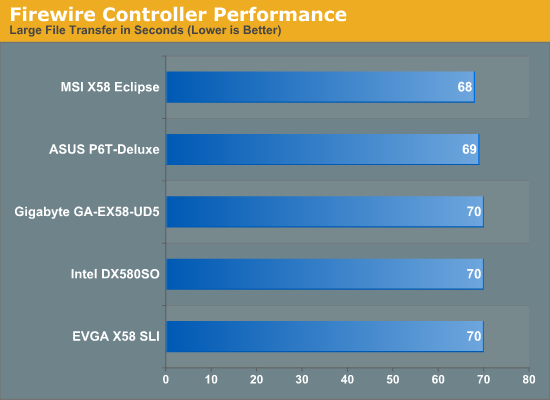
USB performance should be a wash since all the boards use the same ICH10R chipset that provides the USB capabilities. While our synthetic HD Tune tests indicate parity between the boards, the actual transfer of files in the small file test indicates a slight advantage to the ASUS, Gigabyte, and Intel implementations. Our large file USB test is basically a wash as the external hard drive becomes the limiting factor. The VIA FireWire solution on the MSI and ASUS boards hold a small advantage over the Texas Instruments chipset on the other boards.
Networking
The Windows 2000 Driver Development Kit (DDK) includes a useful LAN testing utility called NTttcp. We used the NTttcp tool to test Ethernet throughput and the CPU utilization of the various Ethernet Controllers used on the Intel motherboards. We set up one machine as the server; in this test, an Intel system with an Intel CSA Gigabit LAN connection. Intel CSA has a reputation for providing fast throughput and is a logical choice for our Gigabit LAN server.
On the server side, we used the following Command Line as suggested by the VIA whitepaper on LAN testing:
Ntttcpr -m 4,0,‹server IP› -a 4 -l 256000 -n 30000
On the client side (the motherboard under test), we used the following Command Line:
Ntttcps -m 4,0,‹client IP› -a 4 -l 256000 -n 30000
At the conclusion of the test, we captured the throughput and CPU utilization figures from the client screen.
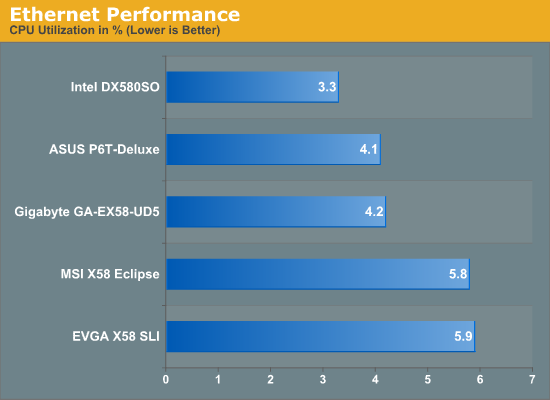
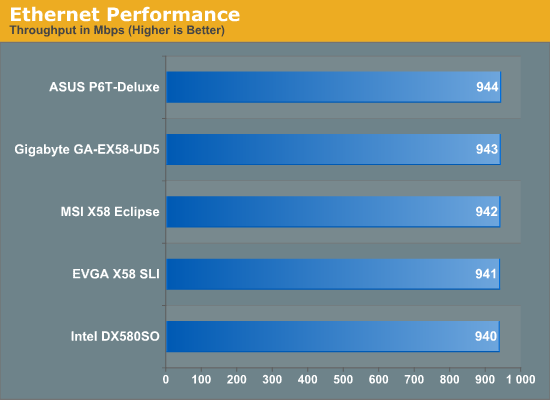
Our network throughput test indicates how well a particular controller design from Realtek, Marvell, or Intel performs instead of being indicative of true chipset performance. This also holds true for the CPU utilization results, though this test can also be influenced to certain degree by the BIOS code and chipset interconnect design.
The CPU utilization numbers favor the integrated GbE controller on the Intel board, followed closely by the Marvell chipset on the ASUS board. The EVGA, MSI, and Gigabyte boards use similar Realtek networking chips, but the Gigabyte board uses the newer RTL8111D over the MSI/EVGA RTL8111Cs. All of the boards feature excellent throughput, with the Marvell solution edging slightly ahead of the Realtek and Intel solutions.










78 Comments
View All Comments
belladog - Saturday, December 6, 2008 - link
Im glad Anandtech is taking a firmer stance with the motherboard makers. I too have seen a degradation in quality over the years.I take what review sites say with a grain of salt. People concerned about stabilty should go to the motherboards makers forums(or other user forums) to really see what to expect with a product.
You dont need to be einstein to realise that manufacturers send hand picked and tweaked products to review sites. Their sales figures depend on a good review, but then the masses who buy the boards/products from the shop see very different results.
Also its hard to poorly rate a product when reviewers have friendships at the companies or depend on advertising revenue from these same companies.
Whats the use of high overclocks if you cant get 4 Gigs of ram to work? Or your new PCI-E 2.0 Video card is having "compatibilty" problems with a board advertised to run it? Then they say its your PSU or memory. The PSU maker blames the motherboard, everyone blames each other and us suckers have to go out and buy 2 PSU's, 2 different ram kits and mix and match to get a working system.
I like to buy high end parts but my experience is its usually not worth it. Most "high end" boards, PSU's , memory are overpriced and provide little or no better experience than a mainstream parts at half the price, except maybe graphics cards where a high priced one will provide a better gaming experience on high settings.
Even in crossfire/SLI an X38/X48 board running at 16X/16X will perform no better than a mainstream P45 board running at 16X/8X. Even worse in some situations.
X58 is a little different because its a whole new architecture that looks interesting but really doesnt offer a huge performance gain. We will probably see the socket 1156 boards performing about the same if the past is anything to go by.
Anyway something needs to change in regards to reviews. Maybe review sites should only test parts obtained from retail channels. Maybe review sites should run a standardised lot of tests before even considering overclocking results. I expect all the advertised features to work correctly as advertised.
Like i said, the best thing consumers can do is, dont take too much notice of reviews and go to the manufacturers forum or other user forums to see what you're really in for.
stungun - Saturday, December 6, 2008 - link
I love the fact you are trying to implement changes in how you review hardware. Personally I do not overclock, dont want to but i do want the newer Intel processor/motherboard combo for 3d rendering and just because it is time to upgrade I should go with the future. Not all your readers want to burn up cpu components some of us just want a good honest working system.shocku - Saturday, December 6, 2008 - link
That's it?!After promising snippets for weeks, the final article is a compilation of what's been said before. That, and more promises future articles will be more in-depth about: RAM… non ES CPUs… the two or three X58 motherboards not covered here…, etc., etc., etc.
I appreciate all the work that goes on behind the scenes to make reviews. But at some point you gotta tell it like it is. If a BIOS or driver wasn't ready-- tough luck. There's plenty of room for other companies to shine by getting things right the first time. Or, are sites like Anandtech the new beta testers?
"We still have several boards to review, ranging from the $220 MSI Platinum up to the $400 Foxconn Bloodrage with several in-between. Our next review will focus on the "lower" end X58 boards from Intel, Gigabyte, Biostar, and MSI. Our final review will feature the upper end boards from ASUS, Gigabyte, DFI, and Foxconn. In between, we will provide a comprehensive OC guide along with a detailed look at memory performance with several DDR3 tri-channel kits from Corsair, OCZ, Patriot, GSkill, Kingston, Crucial, and Mushkin."
Say it isn’t so. Why did I read this article for?
I'll try going from the bottom up...
>I thought the Nehalem memory article was out already. There's that much memory performance left to be covered?
>How can readers make use of "a comprehensive OC guide" that's coming out before "upper end boards"? There's no point if a few bucks more can get you a board that goes as high as your attempts to OC the cheaper one. Might as well pay more and OC more, or pay less if both have the same ceiling.
>The next review will be about lower end boards like Intel's?! Huh?! The Smackover retails for over $250 USD. Unless they have a cheaper board nobody knows about, and they're ready to sell it now; there's NO SUCH THING as a low end X58 board this year.
This article's conclusion, as of 12/05/08, seems impartial and has constructive criticism for the board makers. Perhaps this whole series of articles and blogs will look good to someone reading them for the first time 6 months from now. But, right now, the article is just fodder.
Are readers better off with an expensive board they know thanks to this article, or should they get an even more expensive board that’s been skipped from this review? Heck, maybe the best is a cheaper one whose price puts it in the so-called ‘low end.’
These boards are not $1-$5 dollar items. So, say it like you mean it.
KTHX.
Or... charge manufacturers for all the beta testing you've done and the many 'second' chances they got before you went public. While you're at it, spare us from dealing with ads in your Web site.
PS: I wrote this before I read any comments. Boy am I not alone!
sidewinderx2 - Saturday, December 6, 2008 - link
Err... i'm pretty sure i'm just feeding a troll here... but here goes:Do you not understand what quotation marks mean? You know... somewhat sarcastic? they specifically put the word "lower" in quotation marks, so unless you truly have no grasp of the english language, you must be retarded to think that they actually meant those boards are "low end" boards.
"This article's conclusion, as of 12/05/08, seems impartial and has constructive criticism for the board makers. Perhaps this whole series of articles and blogs will look good to someone reading them for the first time 6 months from now. But, right now, the article is just fodder. "
So... what you're saying is... "WAAAAH! ANANDTECH DIDN'T TELL ME WHAT I SHOULD BUY! WAAAAH! THEY'RE TOO IMPARTIAL! WAAAH! THEY SHOULD BLINDLY GIVE ADVICE OVER THINGS THEY HAVEN'T TESTED YET! WAAAAAAAAH!"
Right.
LtPage1 - Friday, December 5, 2008 - link
Which companies have better quality control out of the gate is information of EXTREME relevance to the consumer. These boards are close enough together in pricing, features, and performance as makes no difference to me. Which company's board had the least problems when it was shipped to you would absolutely sway my purchase. Also, how quickly they dealt with problems you brought up, and how obsessed they were with overclocking performance results to the exclusion of basic functionality would be a huge factor for me.Inform the consumer! Report on hardware? Tell us which companies deserve our money.
chekk - Friday, December 5, 2008 - link
Perhaps you should send the mobo manufacturers a bill for your testing. It sounds like Anandtech provided a very valuable service since clearly the manufacturer's quality assurance processes are not up to the task.Yes, overclocking is fun, but if I buy a production board, it had better be production ready. Also, whether the board is $300 or $65, that sucker better work.
I'd actually like to know which manufacturers we're discussing as I'd like to stop supporting them with my dollars until they get a clue.
Ben - Friday, December 5, 2008 - link
It's hard not to rant here, but I know that rants often get passed over.You guys don't know what a relief it was to read this article. I've been building systems for many years and I have noticed the steady decline in quality.
My latest build was not only the most money I've ever spent on a computer, but also the worst experience I've ever had with a build. I've since sold it off as pieces, while I contemplate buying a preassembled workstation for the first time in my life.
The final straw for me was when I complained about a broken feature to a well-known manufacturer and they told me that I "should have known" what to expect from their product by reading their message boards. In other words, we know it says it does A, B, and C on the box, but if you read our message boards before you bought our product, then you would have known that it doesn't do A, B, and C.
I hope you guys can turn this situation around.
DBissett - Friday, December 5, 2008 - link
Anand's essay on this topic is some of the most important writing I've seen here. Unfortunately, the editorial slant of AT reviews, along with many other sites, has set the stage over the years for exactly what the complaint is about. Anand describes it well...the overriding interest, if not outright obsession, with what often amounts to miniscule performance advantages has literally buried the benefits of simple day to day dependability. Now that this situation has reached such extremes that Anand feels compelled to sound off about it, the task is to turn the editorial focus enough to raise dependability to the higher level of concern that it deserves. Some users in the forums point out at times that different settings or product differences make absolutely no difference in real world use. AT reviews should be equally candid and state, perhaps in bold type, when differences in observed speed are insignificant, and then NOT go on to rank order products on these insignificant speed differences. AT reviews should also go on to provide a rating or at least clear observations about the true ease of use, dependability and satisfaction to be expected by users in general or at different levels of experience, including BIOS issues that the manufacturer has not fixed. It sounds like this might be coming. Great! JDPowers ranks cars on something like initial problems/defects found by new buyers and there's no reason why similar polling/experiences shouldn't be provided for users of what are increasingly expensive computer parts. I hope Anand follows up on this issue and really institutes changes to address it.marsrunner - Friday, December 5, 2008 - link
Thanks for the roundup. Great reading.I bought the i7-920, 12GB of G.Skill PC3-1333 RAM and Asus P6T a couple of weeks ago, and have only had one real problem. My new Logitech Illuminated Keyboard causes the mobo to take about 3 minutes to initialize USB devices at POST, and then when it does POST the keyboard won't work at all until Vista takes over. Very irritating. Haven't contacted ASUS, because I'm sure they'd point the finger at Logitech, who would point the finger back at ASUS. Besides, the keyboard does not cause any problems on my other PC.
I should say that I don't and won't be doing any overclocking, unlike most people around here I imagine, but even so I've noticed a lack of attention to detail in these mobos.
Ecmaster76 - Friday, December 5, 2008 - link
Good article.However the feature tables are a rather large download. If you absolutely must post them as an image please use PNG or GIF. I resaved one in both formats and the size dropped in half without a loss in quality. JPEG is excellent where color content is more important than detail. However the indexed color of PNG and GIF is superior for a 2 color text table where the sharpness of the letters and not the exact shades of those two green is most important.
Also you have a next page link at the bottom of the last page that, of course, goes nowhere.